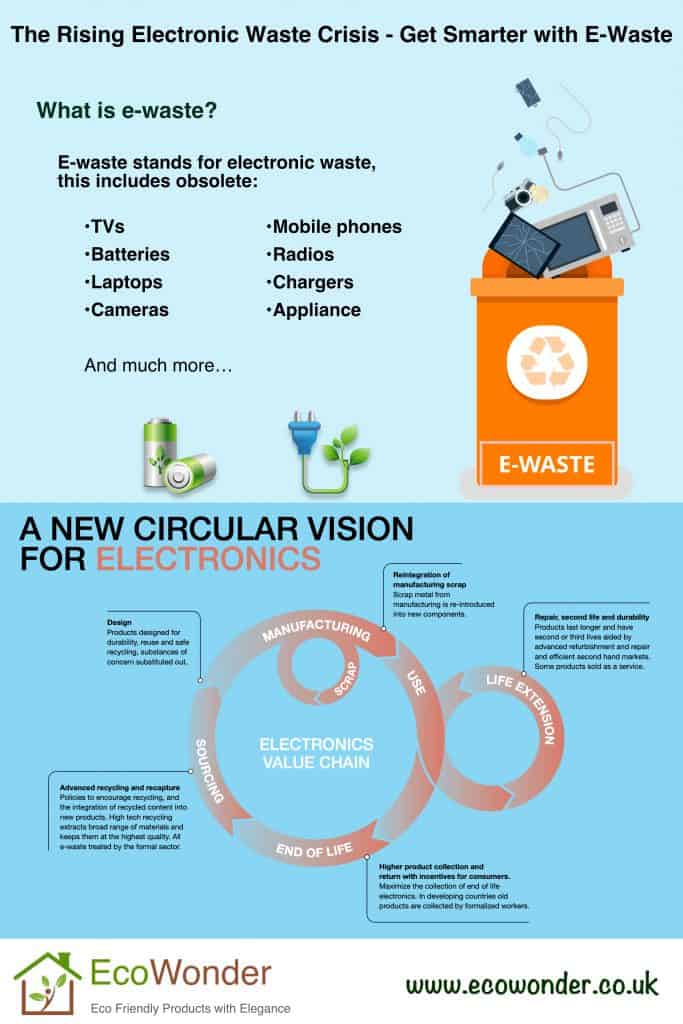We live in a world where nearly every aspect of our lives is ruled by technology — we can’t live without it. There are now more devices connected to the internet than there are humans on this planet. Electronic waste, or e-waste, is the world’s fastest-growing waste stream and becoming a global crisis. Now it is the time to face the scary truth of e-waste and take smarter choices to reduce the severe risk to human and environment.

What Is E-Waste?
E-waste refers to anything with electronic components that is no longer used. Common types of e-waste include mobile phones, computers, televisions, tablets, TVs and many types of home appliances like air conditioning units, toasters, coffee machines, or mains-powered toys. Essentially, e-waste consists of any product with plugs and electronic components. It becomes ‘waste’ when someone stops using the item and either keeps it at home in a drawer, throws it in the bin or sends it to a recycling facility.
Environmental and Health Risks of E-Waste
Millions of tonnes of electronic waste are generated globally every year. As United Nations Environment Programme (UNEP) points out 20-50 million metric tonnes of e-waste are discarded every year, with only 20% of this being recycled. E-waste can be toxic, is not biodegradable and accumulates in the environment, in the soil, air, water and living things. When e-waste becomes landfill, toxic materials from electronic devices are released into bodies of groundwater and soil affecting both land and sea animals. When the waste is warmed up, these harmful chemicals are released into the air and can have a detrimental effect on the atmosphere.
Most people don’t realise that some recycling plants — even trusted or credible ones — ship their e-waste abroad to extract minerals and repurpose parts. While that doesn’t sound terrible, it comes at an enormous cost to local populations. Methods used are almost always improper. For example, open-air burning and acid baths being used to recover valuable materials from electronic components release toxic materials leaching into the environment. These practices can also expose workers to high levels of contaminants such as lead, mercury, beryllium, thallium, cadmium, and arsenic, and brominated flame retardants (BFRs) and polychlorinated biphenyls, which can lead to irreversible health effects, including cancers, miscarriages, neurological damage, and diminished IQs. Informal recycling markets in China, Africa, India, Pakistan, Vietnam, and the Philippines handle anywhere from 50–80% of the world’s e-waste. This obscene form of urban mining has damaging consequences to both the people and the landscape of these areas, creating untold pollution that we’ll be fighting against for decades to come.
Circular Approach for Electronics
A new vision for the production and consumption of electronic and electrical goods is needed. It is easy for e-waste to be framed as a post-consumer problem, but the issue encompasses the lifecycle of the devices everyone uses. The concept of a circular economy encourages a total rethink and redesign of the way we make stuff and its overall lifecycle. Instead of the traditional linear model of “take, make, waste”, the circular economy is a regenerative approach that is both sustainable and creates better value for customers thanks to the increased reuse of products. Designers, manufacturers, investors, traders, miners, raw material producers, consumers, policymakers, and others have a crucial role to play in reducing waste, retaining value within the system, extending the economic and physical life of an item, as well as its ability to be repaired, recycled and reused.
Changes in technology such as cloud computing and the internet of things (IoT) could hold the potential to “dematerialize” the electronics industry. The rise of service business models and better product tracking and takeback could lead to global circular value chains. Material efficiency, recycling infrastructure and scaling up the volume and quality of recycled materials to meet the needs of electronics supply chains will all be essential. If the sector is supported with the right policy mix and managed in the right way, it could also lead to the creation of millions of decent jobs worldwide.
Ways To Reduce E-Waste
As a consumer, we also can take conscious actions to reduce e-waste and its environmental footprint:
1.Extend the life of your electronics
An effective way to reduce your e-waste is to preserve your current electronic possessions as much as possible. Keeping them in good condition, cleaning them regularly and removing excessive debris and dust is a good start. Ensure that you buy screen protectors and hard-wearing cases to prevent damage to them. In addition, you may want to exercise caution when it comes to devices’ batteries; for example, avoid overcharging them and store them in cool, dry places.
2. Donate or sell unneeded electronics
This is one of the best ways you can reduce e-waste. When you donate electronics that still work, you can ensure that they will be put to good use, perhaps in the hands of someone that does not have access to the same level of technology that most people do. If you don’t know anyone that will want it, you can give it to charity or send it to a retailer who will refurbish it and may even give you credit for a new device. Many charities or non-profit organisations accept unwanted electrical donations for onward distribution to schools or communities. Alternatively, they are sold to fund charitable outreach programmes.
3. Take your e-waste to a proper recycling facility
Any items with plugs or charging ports should not be sent to landfill and should be recycled at dedicated Recycling Centres, electrical item banks, or via third-party retailers. Many local councils accept small electricals as part of their residents’ regular home recycling schemes. You may need to consult with your specific local authority to determine the correct process for electrical itemcollection. Alternatively, research online to find out-of-home recycling points to make sure that your items are going to be disposed of correctly and ethically.
4. Buy greener appliances and products
Saving money on purchases has become a priority for many homeowners nowadays, particularly during the cost-of-living crisis. However, buying new electric appliances with high energy ratings is an excellent way to make long-term cost savings. These appliances are designed to be more efficient than standard models, using less energy per day and, as a result, generating far less electronic waste.






